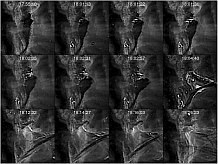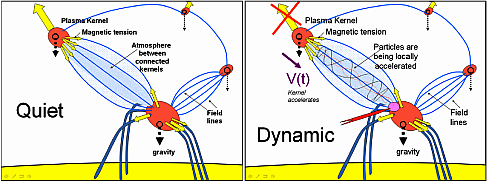


| Title: |
Balance of forces in the corona |
|
| Authors: | ||
| Abstract: | Observed pattern of variability of solar atmosphere plasma structures, often
accompanied by respective measured Doppler shifts, provides a direct evidence of
imbalanced forces acting in this environment. Observed motions have been studied
in various energy bands, extending from radio to hard X-rays using ground and
space-borne instruments. Here, we present the results of a dedicated study of
present observational databases in selected energy ranges with a special
interest focused on TRACE movies. In our search we included also
recently released wavelet-processed EIT and LASCO movies (from SOHO) as
they provide additional support to the conclusions of this study.
The main outcome of the work performed is our better understanding of a basic role played by plasma kernels in every "layer'' of the solar atmosphere. These kernels appear to be present, and rapidly evolve at the locations of violent (intense) energy release locations. Subsequent formation of a more stable coronal magnetic structures seen in the form of "spiders'' or "scorpions'' is due to self-reorganization of plasma kernels. It comes out that the spider structure represents a basic, quasi-equilibrium building block of the solar atmosphere. When observed in a particular image, within a limited energy band, i.e. optical, EUV, soft or hard X-rays, only a part of this spider plasma structure can usually be seen, noticeably resembling a loop-like structure with a brighter top, or an arcade of loops connected along the ridge of summit kernels, or seemingly isolated oval source. This energy-dependent visibility effects caused a general confusion present in solar physics and led to proliferation of a simple fluxtube scenarios. In our study presented herewith, we used the images obtained with the best available resolution, being enhanced numerically where possible. For the first time we enhanced the TRACE image datacube in a systematic way for a particular flare. Based on the results of analysis of a large number of images, we push forward a qualitative toy model of atmospheric connectivity pattern (Sylwester, J. and Sylwester, B., 2004). This hierarchic model is able to handle in a natural way observed complexity of atmospheric phenomena. Here, we discuss to some extend verifiable predictions of the hierarchical model outlining a number of new studies which might prove the concept. These predictions arise concurently with the first data coming down from new missions being recently launched into orbit: the Hinode and the Stereo. |
| FULL VERSION-HTML | ||||
| Get_pdf (371)kb | ||||
| Figures: |
 |
|||
| Figure3.ps.gz |
 |
|||
| Figure5.ps.gz |
 |
|||
Page created by Jaroslaw Bakala
(
jb@cbk.pan.wroc.pl)
Web Curator: Janusz Sylwester
(
js@cbk.pan.wroc.pl)